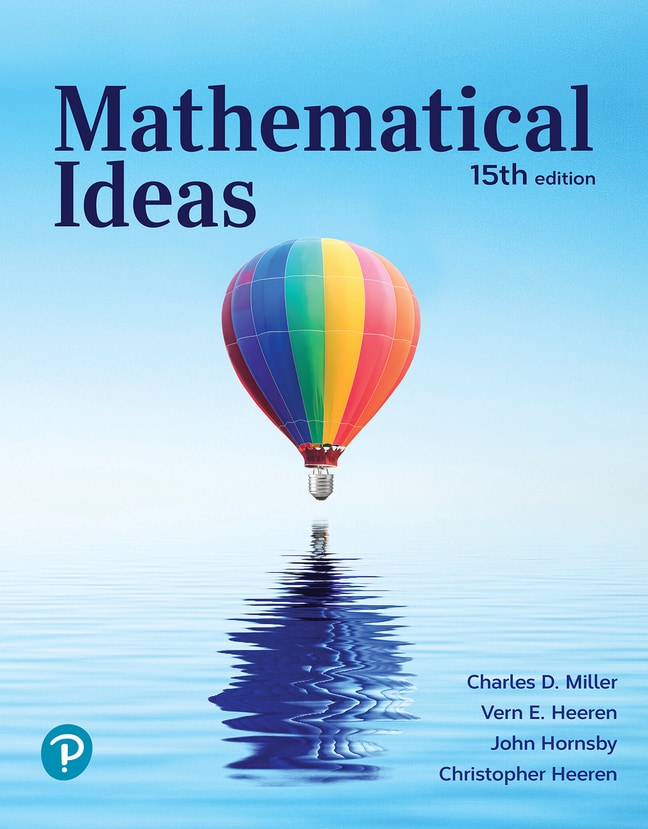
Mathematical Ideas, 15th edition
- Charles D. Miller
- , Vern E. Heeren
- , John Hornsby
- , Christopher Heeren

- Study simpler and faster
Use flashcards and other study tools in your eTextbook
- Watch and learn
Videos & animations bring concepts to life
- Find it fast
Quickly navigate your eTextbook with search
- Stay organized
Access all your eTextbooks in one place
- Easily continue access
Keep learning with auto-renew
Mathematical Ideas connects math to your current and future life and career, with timely and relevant applications. It is designed for non-STEM majors and focuses on math in the workplace, supported by broad coverage, clear organization, abundant examples and well-planned exercise sets. Features like “When Will I Ever Use This?” in each chapter connect topics to career or workplace situations. Problem-solving strategies help increase your problem-solving skills, and “For Further Thought” encourages you to share your reasoning with other students for deeper understanding. Graphing calculators are optional. Among other enhancements, the 15th Edition adds a wealth of updated applications such as Approximating Average Number of Points per Game, Evaluating COVID-19 Risks, and more.
Published by Pearson (October 10th 2023) - Copyright © 2024
ISBN-13: 9780137969036
Subject: Liberal Arts Math
Category: Liberal Arts Math
1. The Art of Problem Solving
- 1.1 Solving Problems by Inductive Reasoning
- 1.2 An Application of Inductive Reasoning: Number Patterns
- 1.3 Strategies for Problem Solving
- 1.4 Numeracy in Today's World
- Summary
- Test
2. The Basic Concepts of Set Theory
- 2.1 Symbols and Terminology
- 2.2 Venn Diagrams and Subsets
- 2.3 Set Operations
- 2.4 Surveys and Cardinal Numbers
- Summary
- Test
3. Introduction to Logic
- 3.1 Statements and Quantifiers
- 3.2 Truth Tables and Equivalent Statements
- 3.3 The Conditional and Circuits
- 3.4 The Conditional and Related Statements
- 3.5 Analyzing Arguments with Euler Diagrams
- 3.6 Analyzing Arguments with Truth Tables
- Summary
- Test
4. Numeration Systems
- 4.1 Historical Numeration Systems
- 4.2 More Historical Numeration Systems
- 4.3 Arithmetic in the Hindu-Arabic System
- 4.4 Conversion Between Number Bases
- 4.5 Arithmetic in Other Bases
- Summary
- Test
5. Number Theory
- 5.1 Prime and Composite Numbers
- 5.2 Large Prime Numbers
- 5.3 Selected Topics from Number Theory
- 5.4 Greatest Common Factor and Least Common Multiple
- 5.5 The Fibonacci Sequence and the Golden Ratio
- 5.6 Magic Squares (online)*
- Summary
- Test
6. The Real Numbers and Their Representations
- 6.1 Real Numbers, Order, and Absolute Value
- 6.2 Operations, Properties, and Applications of Real Numbers
- 6.3 Rational Numbers and Decimal Representation
- 6.4 Irrational Numbers and Decimal Representation
- 6.5 Applications of Decimals and Percents
- Summary
- Test
7. The Basic Concepts of Algebra
- 7.1 Linear Equations
- 7.2 Applications of Linear Equations
- 7.3 Ratio, Proportion, and Variation
- 7.4 Linear Inequalities
- 7.5 Properties of Exponents and Scientific Notation
- 7.6 Polynomials and Factoring
- 7.7 Quadratic Equations and Applications
- Summary
- Test
8. Graphs, Functions, and Systems of Equations and Inequalities
- 8.1 The Rectangular Coordinate Systems and Circles
- 8.2 Lines, Slope, and Average Rate of Change
- 8.3 Equations of Lines
- 8.4 Linear Functions, Graphs, and Models
- 8.5 Quadratic Functions, Graphs, and Models
- 8.6 Exponential and Logarithmic Functions, Graphs, and Models
- 8.7 Systems of Linear Equations
- 8.8 Applications of Linear Systems
- 8.9 Linear Inequalities, Systems, and Linear Programming
- Summary
- Test
9. Geometry
- 9.1 Points, Lines, Planes, and Angles
- 9.2 Curves, Polygons, Circles, and Geometric Constructions
- 9.3 The Geometry of Triangles: Congruence, Similarity, and the Pythagorean Theorem
- 9.4 Perimeter, Area, and Circumference
- 9.5 Volume and Surface Area
- 9.6 Transformational Geometry
- 9.7 Non-Euclidian Geometry and Topology
- 9.8 Chaos and Fractal Geometry
- Summary
- Test
10. Counting Methods
- 10.1 Counting by Systematic Listing
- 10.2 Using the Fundamental Counting Principle
- 10.3 Using Permutations and Combinations
- 10.4 Using Pascal's Triangle
- 10.5 Counting Problems Involving “Not” and “Or”
- Summary
- Test
11. Probability
- 11.1 Basic Concepts
- 11.2 Events Involving “Not” and “Or”
- 11.3 Conditional Probability and Events Involving “And”
- 11.4 Binomial Probability
- 11.5 Expected Value and Simulation
- Summary
- Test
12. Statistics
- 12.1 Visual Displays of Data
- 12.2 Measures of Central Tendency
- 12.3 Measures of Dispersion
- 12.4 Measures of Position
- 12.5 The Normal Distribution
- Summary
- Test
13. Personal Financial Management
- 13.1 The Time Value of Money
- 13.2 Consumer Credit
- 13.3 Truth in Lending
- 13.4 The Costs and Advantages of Home Ownership
- 13.5 Financial Investments
- 13.6 Income Tax Liability
- Summary
14. Graph Theory
- 14.1 Basic Concepts
- 14.2 Euler Circuits and Route Planning
- 14.3 Hamilton Circuits and Algorithms
- 14.4 Trees and Minimum Spanning Trees
- Summary
- Test
15. Voting and Apportionment
- 15.1 The Possibilities of Voting
- 15.2 The Impossibilities of Voting
- 15.3 The Possibilities of Apportionment
- 15.4 The Impossibilities of Apportionment
- Summary
- Test
Answers to Selected Exercises
Credits
Index of Applications
Index